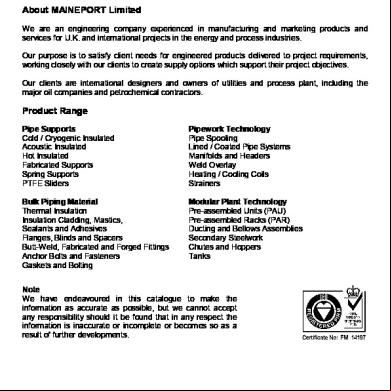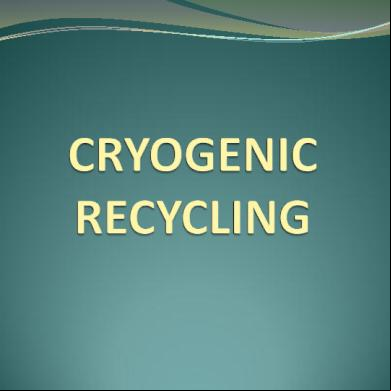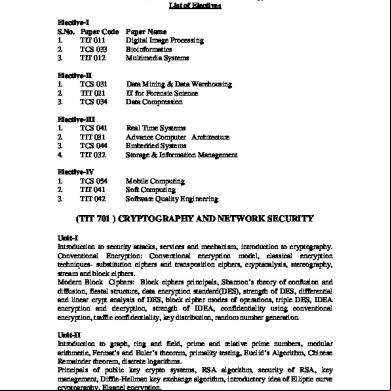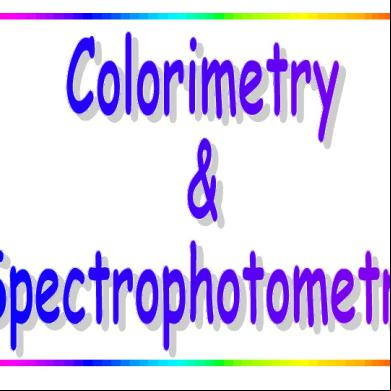Cryogenic Hardening 3i5ke
This document was ed by and they confirmed that they have the permission to share it. If you are author or own the copyright of this book, please report to us by using this report form. Report 2z6p3t
Overview 5o1f4z
& View Cryogenic Hardening as PDF for free.
More details 6z3438
- Words: 580
- Pages: 17
CRYOGENIC HARDENING
CONTENTS • Introduction • Process of cryo treatment • Austenitising • Quenching • Cryo treatment • Tempering • Metallurgical aspects • Benefits of the cryogenics • Applications
INTRODUCTION The word, “Cryogenics” is taken from two Greek words “kryos” which means ‘frost’ or freezing, and “genic” meaning to ‘produce’ or generated. Cryogenic hardening is a Cryogenic heat treating process. Heat treatment is a combination of heating and cooling applied to a metal or alloy. Where the material is cooled to approximately -185 c. Whenever material is subjected to any manufacturing operation, it is subjected to stresses.
Process of Cryo-Heat-Treatment .
Austenitising Austenitization means to heat the iron, iron-based metal, or steel to a temperature at which it changes crystal structure from ferrite to austenite. During austenitising, the final alloying element partitioning occurs between the austenite matrix (that transforms to martensite on cooling) and the retained carbides.
Quenching After Austenitising temperature,the steel is cooled to ambient temperature rapidly in a suitable quenching media like water,oil,air. Once the austenite is cooled below its critical temperature,it becomes unstable and it starts to transform in to martensite After CHT there would always be some retained austenite in the steel.Which is up to 20-30%.
Cryotreatment Cryogenic Treatment (CT) of tool materials consists of three stages 1) cooling of tool material fromroom temperature, at an extremely slow rate ranging from0.5 to 1 C/min, 2)Shallow Cryogenic Treatment (SCT) for the period of -84 C 3) Deep Cryo-genic Treatment (DCT) for the period of -196 C
Tempering Tempering is the process of reheating the steel at predetermined temperatures which is lower than the transformational temperature Martensite precipitates fine carbides, which are named as transition carbides. Nucleation of these carbides relieves micro-stresses inthe brittle primary martensite and prevents micro cracking on surface of the steel
Metallurgical Aspects Transformation Martensite
of
Retained
Austenite
to
- After CHT there would always be some retained austenite in the steel.Which is up to 20-30%. - The retained austenite as a soft phase in steels could reduce the product life, it can be transformed into martensite
Precipitation of Fine η- Carbides Deep cryogenics is due to an enhancement of the precipitation of fine eta-carbides during the subsequent temper. -The strain energy in the martensite lattice increases at a lower temperature. As a consequence Carbon atoms migrate and form a clusters. - During the subsequent heating back to the room temperature or even a tempering, these clusters act as nuclei for the formation of the ultra fine etacarbides.
Cryogenic agent A "cryogenic agent" is an agent (solid, liquid or gas) that can be used to cool an object to cryogenic temperatures, namely temperatures below below –150 °C (–238 °F).
Benefits of Cryogenics • Promotes a more uniform micro-structure • Reduces abrasive and adhesive wear • Permanently changes the structure of the metal resulting in improved machining properties • Improved surface finishing • Reduce the cost of tool remanufacture
Applications • Gun barrels: increases the wear life of the barrel and makes cleaning easier and faster. • Grinding: allows a better cut, less, a better finish, and less tensile residual induced into the work piece. • Machining: lathes, drill bits, cutting and milling tools • Dental and Surgical Instruments • Engine parts:
Conclusion Cryogenic hardening is a permanent, nondestructive, non-damaging process, which reduces abrasive wear , relieves internal stress, minimizes the micro cracking due to shock forces, lengthens part life, and increases performance.
References www.sciencedirect.com/ en.wikipedia.org/wiki/ScienceDirect Material science and metallurgy- Kestoor praveen
THANK YOU
CONTENTS • Introduction • Process of cryo treatment • Austenitising • Quenching • Cryo treatment • Tempering • Metallurgical aspects • Benefits of the cryogenics • Applications
INTRODUCTION The word, “Cryogenics” is taken from two Greek words “kryos” which means ‘frost’ or freezing, and “genic” meaning to ‘produce’ or generated. Cryogenic hardening is a Cryogenic heat treating process. Heat treatment is a combination of heating and cooling applied to a metal or alloy. Where the material is cooled to approximately -185 c. Whenever material is subjected to any manufacturing operation, it is subjected to stresses.
Process of Cryo-Heat-Treatment .
Austenitising Austenitization means to heat the iron, iron-based metal, or steel to a temperature at which it changes crystal structure from ferrite to austenite. During austenitising, the final alloying element partitioning occurs between the austenite matrix (that transforms to martensite on cooling) and the retained carbides.
Quenching After Austenitising temperature,the steel is cooled to ambient temperature rapidly in a suitable quenching media like water,oil,air. Once the austenite is cooled below its critical temperature,it becomes unstable and it starts to transform in to martensite After CHT there would always be some retained austenite in the steel.Which is up to 20-30%.
Cryotreatment Cryogenic Treatment (CT) of tool materials consists of three stages 1) cooling of tool material fromroom temperature, at an extremely slow rate ranging from0.5 to 1 C/min, 2)Shallow Cryogenic Treatment (SCT) for the period of -84 C 3) Deep Cryo-genic Treatment (DCT) for the period of -196 C
Tempering Tempering is the process of reheating the steel at predetermined temperatures which is lower than the transformational temperature Martensite precipitates fine carbides, which are named as transition carbides. Nucleation of these carbides relieves micro-stresses inthe brittle primary martensite and prevents micro cracking on surface of the steel
Metallurgical Aspects Transformation Martensite
of
Retained
Austenite
to
- After CHT there would always be some retained austenite in the steel.Which is up to 20-30%. - The retained austenite as a soft phase in steels could reduce the product life, it can be transformed into martensite
Precipitation of Fine η- Carbides Deep cryogenics is due to an enhancement of the precipitation of fine eta-carbides during the subsequent temper. -The strain energy in the martensite lattice increases at a lower temperature. As a consequence Carbon atoms migrate and form a clusters. - During the subsequent heating back to the room temperature or even a tempering, these clusters act as nuclei for the formation of the ultra fine etacarbides.
Cryogenic agent A "cryogenic agent" is an agent (solid, liquid or gas) that can be used to cool an object to cryogenic temperatures, namely temperatures below below –150 °C (–238 °F).
Benefits of Cryogenics • Promotes a more uniform micro-structure • Reduces abrasive and adhesive wear • Permanently changes the structure of the metal resulting in improved machining properties • Improved surface finishing • Reduce the cost of tool remanufacture
Applications • Gun barrels: increases the wear life of the barrel and makes cleaning easier and faster. • Grinding: allows a better cut, less, a better finish, and less tensile residual induced into the work piece. • Machining: lathes, drill bits, cutting and milling tools • Dental and Surgical Instruments • Engine parts:
Conclusion Cryogenic hardening is a permanent, nondestructive, non-damaging process, which reduces abrasive wear , relieves internal stress, minimizes the micro cracking due to shock forces, lengthens part life, and increases performance.
References www.sciencedirect.com/ en.wikipedia.org/wiki/ScienceDirect Material science and metallurgy- Kestoor praveen
THANK YOU










